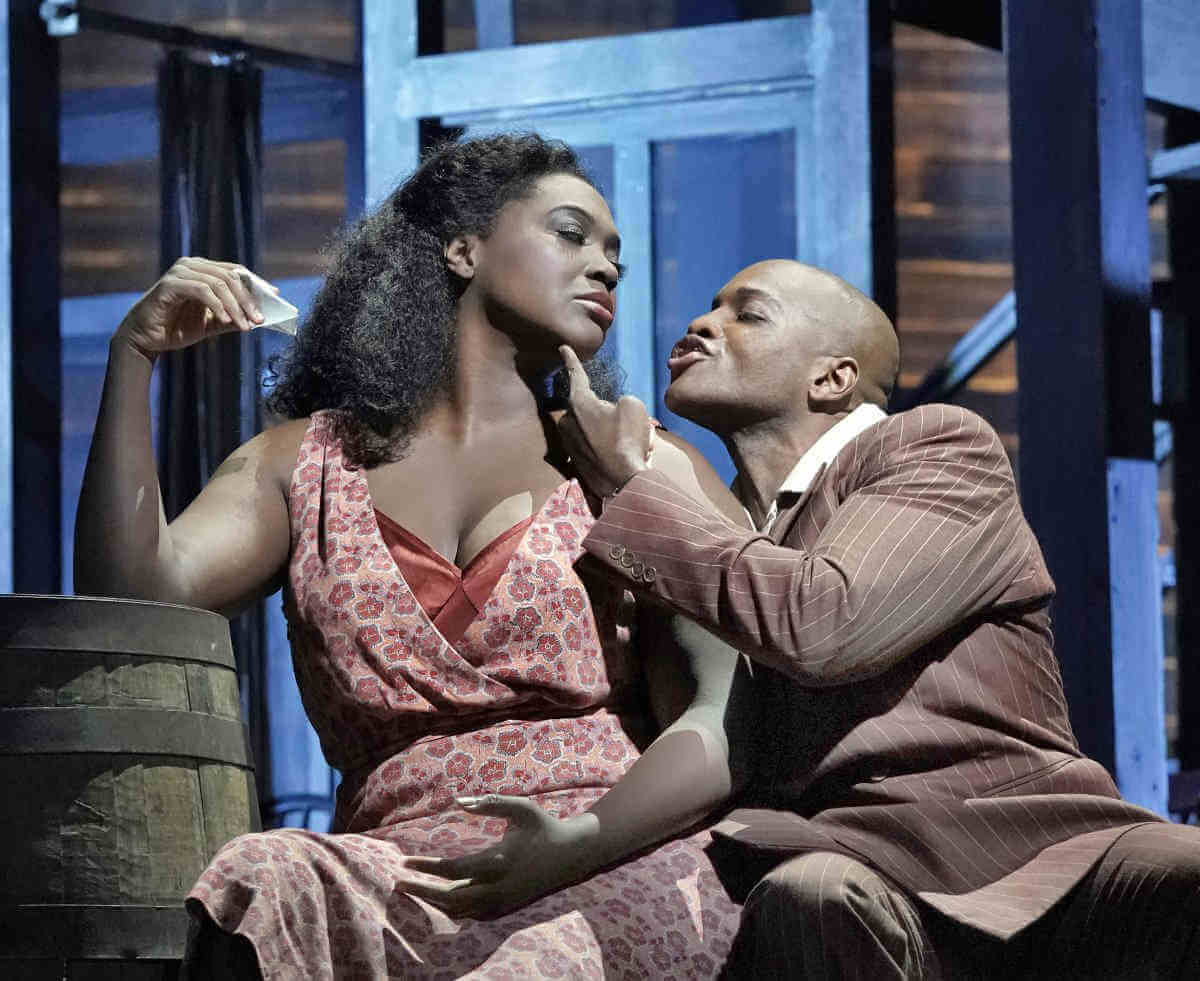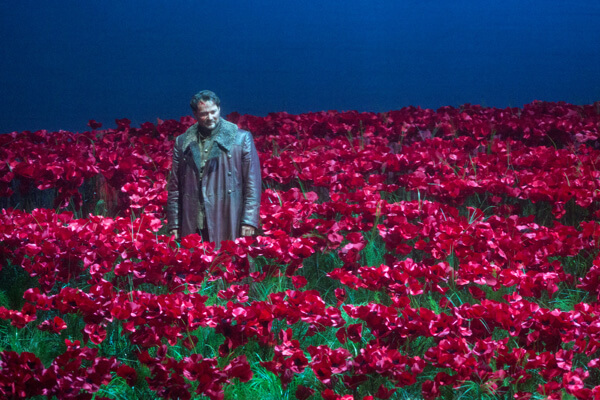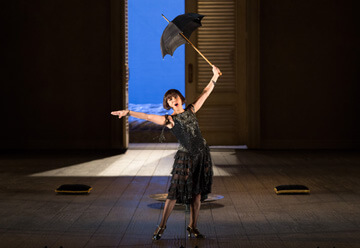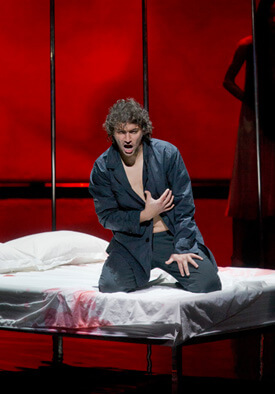Gershwin’s folk opera “Porgy and Bess” is a hybrid work considered difficult to classify at its 1935 premiere; its form and content changed during its genesis. It has been subjected to tinkering ever since on operatic and Broadway stages and on film. It is a portrait of the lives of the black community in Charleston, South Carolina, as seen through the gaze of white men: original author and librettist DuBose Heyward (and his wife Dorothy), stage director Rouben Mamoulian, and composer and librettist George and Ira Gershwin. Initially considered a powerful statement of the dignity and resilience of African-Americans, it was denounced as racist by the NAACP in the 1950s. My late friend Barbara, a black woman, called it a “minstrel show.”
“Porgy and Bess” is many things to many people and it changes or is changed according to what people want from it: a Broadway musical with a score cut down as it became in the 1940s and 2012 Broadway revivals? Or a grand opera as it became in the 1976 Houston Grand Opera production that toured and the long delayed 1985 Metropolitan Opera premiere? Both those operatic productions restored music that Gershwin and Mamoulian cut before the Broadway opening. Jazz artists have brilliantly reinterpreted Gershwin’s songs in their idiom.
The Metropolitan Opera’s new production that opened the season evidently is giving the contemporary audience what they want — the run (through February 1) is nearly sold out and the critical reception has been largely positive. The Met is using an expanded opera house version of the score with some judicious cuts — the evening still runs more than three hours. I enjoyed the stripped down and dramatically cogent 2012 Broadway production starring Audra MacDonald — the main plot of “Porgy and Bess” is fairly simple with a lot of background incident. Cutting a lot of the extra music — involving the chorus as the denizens of Catfish Row — put a stronger focus on the lead characters, creating stronger dramatic propulsion. In the Metropolitan Opera’s new production, it is the choral ensemble embodying the Catfish Row community that emerges as the breakout star.
Met chorus director Donald Palumbo has recruited a special “Porgy” chorus of African-American singers who act and sing thrillingly as an ensemble under production director James Robinson’s guidance. Solo lines reveal that there are world-class voices emerging from the choir that rival (and in a few cases surpass) the main performers. The chorus is also comfortable with the fusion of jazz and gospel styles with the classical in Gershwin’s score that eludes most of the lead performers. The ensemble creates a true Catfish Row community that will survive despite the tragedy and hardship that threaten their marginal existence.
The Met’s lead cast make a strong team with a hole in the center: Eric Owens’ Porgy emerges as a recessive cipher. Owens’ dull, worn bass-baritone strains to reach high notes. His acting is often inert — he spends a lot of time sitting down, doesn’t muster enough rage to convincingly kill Crown in Act II, and fails to register any great emotional intensity until his final scene culminating with “Oh Lawd, I’m on my Way.”
Owens’ Porgy seems to be a generation or two older than his Bess — the radiant and blooming young soprano star Angel Blue — and his chemistry with his love interest is more paternal than sexual or romantic. Blue’s problem is due to her strengths as a performer. Though she brings a fresh, voluptuous voice and presence onstage, she doesn’t look as damaged or used as the drug addict Bess should even though she unsparingly portrays Bess’ compulsive addiction to “happy dust,” going so far as to snort it off the floor. Blue’s rich soprano combines the necessary spinto thrust with lyric radiance. She has natural charisma that compels you to watch her every move. Blue has the potential to give us an even better Bess — time and experience will reveal it. Both leads could have benefited from better personal direction and staging in their intimate scenes than what director Robinson has given them.
Robinson’s staging is more effective in the wide frame than close-up intimacy. His main focus is the ensemble who often upstage the leads — literally they are placed front and center putting Porgy and Bess on the sidelines. Camille A. Brown’s delightful choreography uses vernacular dance movements that look spontaneous and unrehearsed. But Brown also puts her dancers downstage center where their whooping and stomping sometimes overwhelm the music. Michael Yeargan’s mobile Catfish Row sets are an airy multilevel wooden framework of buildings that be reconfigured in different angles. The interludes feature a drop curtain depicting an ocean shore with docks and recorded seagull cries. Like Catherine Zuber’s rather clean and new-looking costumes, it all looks like a minimalist stylization of a ghetto rather than the squalid real thing.
Ryan Speedo Green as Jake has the best male voice in the cast and a heroic leading man presence — you miss him when he leaves the stage. As Clara, who opens the opera with “Summertime,” Golda Schultz unfurls a shimmering crystalline soprano that ravishes the ear. Soprano Latonia Moore lacks the dark low tones that mezzo-soprano Serenas have brought to “My Man’s Gone Now” but she is radiant in her prayer to “Doctor Jesus” in Act II. Her engaging stage presence and sweet tone won ovations. Alfred Walker’s huge craggy baritone and hulking presence make Crown a frightening loose cannon ready to wreak havoc at any moment. Veteran Denyce Graves plays Maria as a tough cookie rather than warm earth mother — her flinty mezzo-contralto matches her characterization. Frederick Ballentine’s Sportin’ Life is a youthful operatic lyric tenor with access to head tones and a lithe frame. He is not a vaudeville song and dance showman as the role creator John W. Bubbles, Cab Calloway, or the 1959 film’s Sammy Davis Jr. were. Cameo turns like Leah Hawkins’ showstopping Strawberry Woman and Chauncey Packer’s Crab Man get the hybrid style down.
The Met downplays the hybrid popular and ethnic music elements in Gershwin’s score. David Robertson’s interpretation — masterfully performed by the Metropolitan Opera Orchestra — is solidly 20th century American classical in the Aaron Copland vein with barely a hint of jazz or Broadway. Under his baton, “I Got Plenty of Nuttin” doesn’t swing (especially with Owen’s leaden rendition) and Ballentine’s “It Ain’t Necessarily So” lacks a sassy Broadway strut. Also, all the performers soften or omit Heyward’s and Ira Gershwin’s imitation of the Gullah dialect — “wid” becomes “with,” for example. The Gullah dialect is accurate for the time, place, and people depicted here but is too reminiscent of “Amos ‘n’ Andy” and Stepin Fetchit for our current generation of performers and audiences.
This opera house Catfish Row looks and sounds just a little too refined and cleaned up — gentrification (like political correctness) is a wave we can’t swim against in the 21st century. This critic wanted a little more grit and desperation — some sweat and some tears along with a little jazz and gospel. But a sense of community unified by superb musicianship is there in the ensemble carrying the evening to triumph.




































